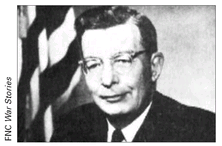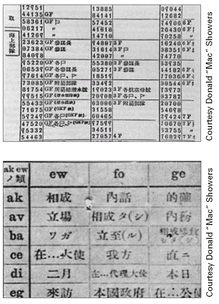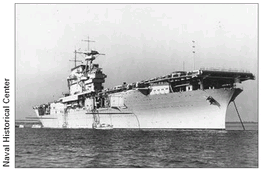War Stories II (23 page)
Authors: Oliver L. North

Â
Commander Edward Layton

That night, aware of his commander's desperation, Rochefort devised a brilliant and devious scheme to trap the Japanese into revealing their target. Using the secure underwater cable between Oahu and Midway, he sent instructions to Marine Air Group 22 on Midway to broadcast a routine radio message “in the clear”âmeaning unencryptedâthat they were running short of fresh water. The Marines complied, broadcasting the innocuous message over their standard high-frequency “administrative & logistics” radio.
Fewer than twelve hours later, early on the morning of 20 May, an Australian intercept site transcribed a Combined Fleet coded message to Yamamoto informing him that a Japanese submarine had reported hearing a radio call: “The aviation unit on AF is running short of fresh water.”
Thanks to Station Hypo, Nimitz finally knew the target. And later that day, Rochefort's code-breakers gave him another piece of vital but frightening information: the attacks were scheduled for 3 June in the Aleutians, and for 4 June on Midway.
Nimitz now knew the targets and the dates of attack. He correctly judged that the Aleutian invasion for the third was a deception designed by Yamamoto to draw U.S. forces away from Hawaii and Midway. And while Nimitz didn't want to lose even another inch of American territory to the Japanese, the tiny islands of Adak, Attu, and Kiska were expendable compared with the strategically valuable Midway. If Yamamoto managed to seize the little atoll, Hawaii itself would be vulnerable, and with Japanese long-range land-based patrol aircraft and submarines operating from the Aleutians in the north Pacific and from Midway in the central Pacific, he would have only one way of striking backâthrough the narrow channels of the South Pacific islands. By the morning of 21 May there was no doubt in the mind of Chester Nimitz: He had to hold Midway. The only questions now were: How? And with what?
Â
Japanese codebooks

The commander of the Pacific Fleet wasn't one to waste time worrying. Nimitz ordered the Midway harbor and beaches mined and barbed wire emplaced. Seventeen Army Air Force B-17sâall he had to spareâwere ordered to Midway. On 25 May, the seaplane tender
Kitty Hawk
delivered additional fighter planes and dive-bombers to the island, bringing the little airstrip up to a complement of sixty old Navy and Marine fighters and dive-bombers that had been taken off carrier duty, along with six new TBD torpedo planesâthe first to reach the Pacificâtwenty-three land-based bombers, and thirty-two of the new but untested Catalina PBY bombers.
Kitty Hawk
delivered additional fighter planes and dive-bombers to the island, bringing the little airstrip up to a complement of sixty old Navy and Marine fighters and dive-bombers that had been taken off carrier duty, along with six new TBD torpedo planesâthe first to reach the Pacificâtwenty-three land-based bombers, and thirty-two of the new but untested Catalina PBY bombers.
He ordered the
Hornet
and the
Enterprise
to steam at flank speed back to Hawaii to refuel and re-arm so that they could get in position northeast of Midway to meet the onslaught. He dispatched every available submarine in the Pacific Fleetânineteen in allâto screen the island's western approaches. To ensure that the Japanese wouldn't have a free ride in the Aleutians, he ordered several smaller bases evacuated and sent a surface force of five cruisers, fourteen destroyers, and six submarines under the command of Rear Admiral Robert A. Theobald to do their best at disrupting the Japanese landings in Alaska.
Hornet
and the
Enterprise
to steam at flank speed back to Hawaii to refuel and re-arm so that they could get in position northeast of Midway to meet the onslaught. He dispatched every available submarine in the Pacific Fleetânineteen in allâto screen the island's western approaches. To ensure that the Japanese wouldn't have a free ride in the Aleutians, he ordered several smaller bases evacuated and sent a surface force of five cruisers, fourteen destroyers, and six submarines under the command of Rear Admiral Robert A. Theobald to do their best at disrupting the Japanese landings in Alaska.
Meanwhile, as the Japanese Combined Fleet headed east, the battle-damaged USS
Yorktown
was making her way from Tonga to Pearl Harbor. Navy Aviation Mechanic Bill Surgi was still aboard.
Yorktown
was making her way from Tonga to Pearl Harbor. Navy Aviation Mechanic Bill Surgi was still aboard.

AVIATION MECHANIC BILL SURGI, USN
Aboard the USS
Yorktown
Pearl Harbor, Hawaii
27 May 1942
Aboard the USS
Yorktown
Pearl Harbor, Hawaii
27 May 1942

We went from the Coral Sea to Tonga to survey the damage. The
Yorktown
was pretty well shot up. We had near misses on the port side, which gave us an oil leak. After patching her up as well as we could with all hands working around the clock, we headed for Pearl. It took us over a week to get back, and the damage-control people and the engineers they flew down to Tonga estimated, “It's gonna take ninety days to fix her.”
Yorktown
was pretty well shot up. We had near misses on the port side, which gave us an oil leak. After patching her up as well as we could with all hands working around the clock, we headed for Pearl. It took us over a week to get back, and the damage-control people and the engineers they flew down to Tonga estimated, “It's gonna take ninety days to fix her.”
Well, we got to Pearl Harbor, working on her the whole way, and when we pulled into port, they never really repaired it. For all the shrapnel holes in the hull and the fuel and water tanks, they drilled wooden pegs of different sizes and shapes that would fit the holes and we drove them in with sledgehammers to make her watertight. In the spaces below decks where the bombs had gone off, they put in big timbers and welded beams across to shore up the decks and bulkheads. Nobody got shore
leave like we usually did when we came into port. We had shipyard workers on board, and our working parties were going around the clock. Nobody slept.
leave like we usually did when we came into port. We had shipyard workers on board, and our working parties were going around the clock. Nobody slept.
To fix the holes that the bombs had made in the flight deck, they hoisted aboard big metal plates and we fastened them down with four big metal spikes, one in each corner. Then, after just three days, we got the word that we were going back out.
The ship was not what we call seaworthy, but the flight deck was operational. The
Yorktown
's air group was still intact; the squadrons were brought up to full strength and everybody was on board. As we were leaving Pearl Harbor, the skipper comes over the ship's address system and says, “We're going to help out at Midway.”
Yorktown
's air group was still intact; the squadrons were brought up to full strength and everybody was on board. As we were leaving Pearl Harbor, the skipper comes over the ship's address system and says, “We're going to help out at Midway.”
 PEARL HARBOR SHIPYARDS
PEARL HARBOR SHIPYARDSOAHU, HAWAII
28 MAY 1942
28 MAY 1942
Admiral “Bull” Halsey's Task Force 16, composed of the USS
Enterprise
and USS
Hornet
and their escorts, arrived at Pearl Harbor on 26 May. The next day Task Force 17, with Admiral Fletcher shepherding the crippled USS
Yorktown
âtrailing a miles-long oil slickâlimped into Pearl for repairs. The damage assessment for fixing the
Yorktown
was ninety days. Halsey ordered them to make her ready for sea in three days. Working night and day, yard workers and the crew made repairs so that the carrier could launch and land aircraft again. They did it, and Nimitz came aboard to pronounce the vessel “ready for action” even though repairs continued as the ship sailed.
Enterprise
and USS
Hornet
and their escorts, arrived at Pearl Harbor on 26 May. The next day Task Force 17, with Admiral Fletcher shepherding the crippled USS
Yorktown
âtrailing a miles-long oil slickâlimped into Pearl for repairs. The damage assessment for fixing the
Yorktown
was ninety days. Halsey ordered them to make her ready for sea in three days. Working night and day, yard workers and the crew made repairs so that the carrier could launch and land aircraft again. They did it, and Nimitz came aboard to pronounce the vessel “ready for action” even though repairs continued as the ship sailed.
But when the
Enterprise
, the
Hornet
, and their screen of five heavy cruisers, one light cruiser, and nine destroyers constituting Task Force 16, sortied from Pearl Harbor en route to Midway on 28 May, Halsey wasn't aboard. He had been taken to a hospital in Hawaii for a severe case of dermatitisâseemingly not a serious condition, but after months of combat at sea, it had become a problem for the hard-nosed admiral, keeping him from
sleeping. The doctors ordered the tenacious commander to bed rest, and Rear Admiral Raymond A. Spruance took command of the two-carrier Task Force 16, while overall command was handed to Admiral Fletcher aboard the battered but bandaged
Yorktown
with Task Force 17.
Enterprise
, the
Hornet
, and their screen of five heavy cruisers, one light cruiser, and nine destroyers constituting Task Force 16, sortied from Pearl Harbor en route to Midway on 28 May, Halsey wasn't aboard. He had been taken to a hospital in Hawaii for a severe case of dermatitisâseemingly not a serious condition, but after months of combat at sea, it had become a problem for the hard-nosed admiral, keeping him from
sleeping. The doctors ordered the tenacious commander to bed rest, and Rear Admiral Raymond A. Spruance took command of the two-carrier Task Force 16, while overall command was handed to Admiral Fletcher aboard the battered but bandaged
Yorktown
with Task Force 17.
The
Yorktown
left Pearl Harbor with Fletcher aboard on 29 May and rendezvoused with the
Hornet
and the
Enterprise
150 miles northeast of Midway on 2 June.
Yorktown
left Pearl Harbor with Fletcher aboard on 29 May and rendezvoused with the
Hornet
and the
Enterprise
150 miles northeast of Midway on 2 June.
The timing of the Americans' departure from Pearl Harbor was impeccable. Though Yamamoto was fairly certain that
Enterprise
and
Hornet
were in the South Pacific, he had ordered Japanese submarines to be positioned in Hawaiian waters by 1 June to intercept any other carriers or major combatants that might have arrived from the U.S. mainland. If they couldn't sink them, they were to at least warn the rest of the Combined Fleet if the Americans sailed when the Aleutians were attacked on 3 June. He also dispatched seaplanes from the Japanese-held Marshall Islands on 1, 2, and 3 June to scout Hawaii and carry out the same task. But neither the subs nor the scout planes arrived until well after the two American carrier task forces had already sailed. The Japanese, believing that they had sunk both the
Yorktown
and the
Lexington
in the Coral Sea battleâand now more convinced than ever that Halsey was still in the South Pacific with the
Hornet
and the
Enterprise
âthought they had nothing to fear as they closed in for a surprise attack on Midway.
Enterprise
and
Hornet
were in the South Pacific, he had ordered Japanese submarines to be positioned in Hawaiian waters by 1 June to intercept any other carriers or major combatants that might have arrived from the U.S. mainland. If they couldn't sink them, they were to at least warn the rest of the Combined Fleet if the Americans sailed when the Aleutians were attacked on 3 June. He also dispatched seaplanes from the Japanese-held Marshall Islands on 1, 2, and 3 June to scout Hawaii and carry out the same task. But neither the subs nor the scout planes arrived until well after the two American carrier task forces had already sailed. The Japanese, believing that they had sunk both the
Yorktown
and the
Lexington
in the Coral Sea battleâand now more convinced than ever that Halsey was still in the South Pacific with the
Hornet
and the
Enterprise
âthought they had nothing to fear as they closed in for a surprise attack on Midway.
Â
USS
Yorktown
Yorktown

Other books
Girl's Guide to Witchcraft by Mindy Klasky
Seducing Professor Coyle by Darien Cox
If the Earl Only Knew (The Daring Marriages) by Amanda Forester
Kill the Competition by Stephanie Bond
Even Now by Susan S. Kelly
The Dishonest Murderer by Frances Lockridge
Blood Abandon (Donald Holley Book 1) by Avery Stites
The Panda Theory by Pascal Garnier
Pirate: Space Gypsy Chronicles, #1 by Eve Langlais
A Marquess for Christmas (Scandalous Seasons Book 5) by Christi Caldwell
